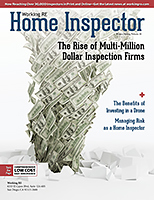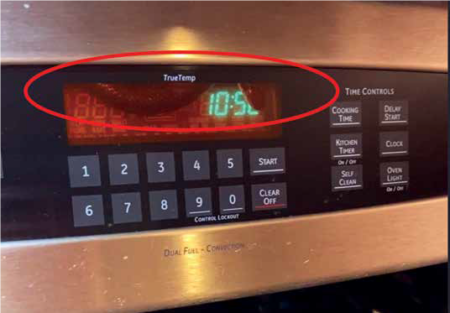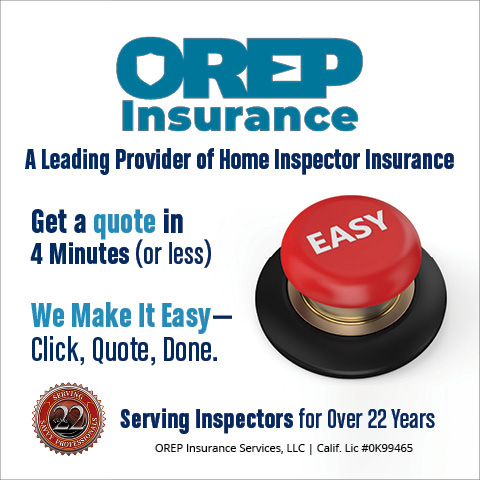 | > E&O/GL Insurance for Home Inspectors Competitive Rates, Broad Coverage, Free Risk Management, online inspection support for tough questions, discounts on education and more… Professional Coverage, Competitive Pricing Shop OREP today! |
Tips on Safety and Dealing with Snakes
By Nick Massimo, Snake Guru, LLC
I own Snake Guru, LLC, a wildlife control business where I specialize in working with snakes. Ironically, my job takes me to many of the same hazardous places as home inspectors.
Just like you, I need to be methodical and highly attentive to detail. On an average day, I get dirty investigating areas of a property few others visit. It’s a big responsibility requiring accountability, professionalism and being mindful of hazards.
My company safely removed this black rat snake from the INSIDE of an oven control panel (See Figure 1).

Figure 1: Snake Inside Oven Control Panel
Enlarged Image
A notable fraction of my clients start as a human-wildlife conflict needing immediate attention. During my “standard” workday, I’m often called to a scene where a snake has been observed at least once. This is where I get to put on my detective cap to figure out why a snake is occupying a place they aren’t frequently encountered.
Regardless of whether you’re a friendly neighborhood snake professional, a property inspector, or work in another related profession, here are tips to help you stay as safe as possible.
Snake Tracks
Animals may leave a variety of signs if they’ve recently been in the area. Footprints, scratch marks, hair, feathers, are all great examples. Snakes, however, can’t leave any of those signs behind. Instead, the signs are a bit subtler. Snakes may leave shed skin, feces, or slide marks behind on the ground if you are lucky! Don’t forget, even though snakes lack arms and legs, that doesn’t stop them from climbing up above eye level.
Another thing to keep in mind, people often come across snakes in a building if there’s an existing rodent problem. If inspecting an area and you come across signs of rodents, be aware a snake may also be around looking for a meal.
Venomous Versus Nonvenomous Snakes
This may be the most important lesson from the entire article. No matter where you live in the world, people want a trick to help them identify if a snake should be considered a health threat. After studying snakes all over the world, Snake Guru has a very special trick to help you identify a venomous snake anywhere and not get bit.
Want to know our foolproof trick!? See what you think is a snake? Back away slowly in the opposite direction. The best thing someone can do to try and protect themselves is NOT touch a snake. It’s slightly anticlimactic and not necessarily a trick, but the mentality will surely keep you safe. All snakes should be considered dangerous unless you are one hundred percent certain otherwise.
If you’re bit by a snake, you should immediately notify and call 911 to inform them of your location and what happened. Leave the animal alone and don’t attempt to capture it. Consider taking a picture if you can do so safely. If possible, have another person drive you to the nearest emergency department. Prior to getting to the hospital, follow these steps:
- Remain as calm as possible.
- Remove your belt & jewelry (rings, bracelets, watches, etc.)
- Call your local Poison Control Center, (1-800-222-1222), on the way to the hospital.
(story continues below)
(story continues)
Very Bad Ideas
- DO NOT try and suck the venom out of the wound with your mouth.
- DO NOT apply a tourniquet to the bite area.
- DO NOT cover the bite area with ice.
- DO NOT cut open the bite wound to try and get the venom out.
- DO NOT attempt to catch the snake. Get to the hospital.
The large majority of encounters with wildlife pass without any incident. Of the small fraction of human-wildlife encounters ending in conflict, many of them could have been avoided had the person known highly specialized business exist striving to turn conflict into conservation.
Walk the Enlightened Path
This sounds simple enough, but only place your hands and feet where you can clearly see. If it’s dark, you need to stop, get a flashlight and illuminate the area before proceeding. Whether it’s a snake, low-hanging nail, or broken flooring, every step needs to be taken carefully.
Masks, Booties, and Body Suits
Wearing the proper personal protective equipment (mask/respirator, Tyvek® suit, booties, etc.) is extremely important for your own personal safety, but also that of your client(s). Outside of live snakes and other pest hazards, when entering a place like an attic or crawlspace, there is no telling what microscopic hazards might be disturbed.
If animal urine/feces are disturbed, there’s a very serious risk of inhaling aerosolized viral or bacterial pathogens. Asbestos is another big concern in attics and crawlspaces. When inspecting an attic or crawlspace, make sure you always put a mask on before opening the door.
Before entering and immediately after exiting a potentially ‘dirty’ space, set up an area to contain any mess. Consider laying down a thin piece of plastic wrap to help quickly clean up any debris. It shows a high degree of professionalism to make these small changes to your standard operating procedures. It is very easy to do and people will notice the extra effort!
About the Author
Nick Massimo owns Snake Guru, LLC and specializes in providing 24-hour snake removal, fencing and prevention services in the Greater Phoenix area. Massimo uses these opportunities to catalyze a more informed understanding of how to live alongside wildlife, and prevent future incidents. If faced with a human-wildlife conflict in another area, consider searching our list of certified, licensed colleagues across the country: nwcoa.com/wildlife-professional-directory/.
OREP Insurance Services, LLC. Calif. License #0K99465


